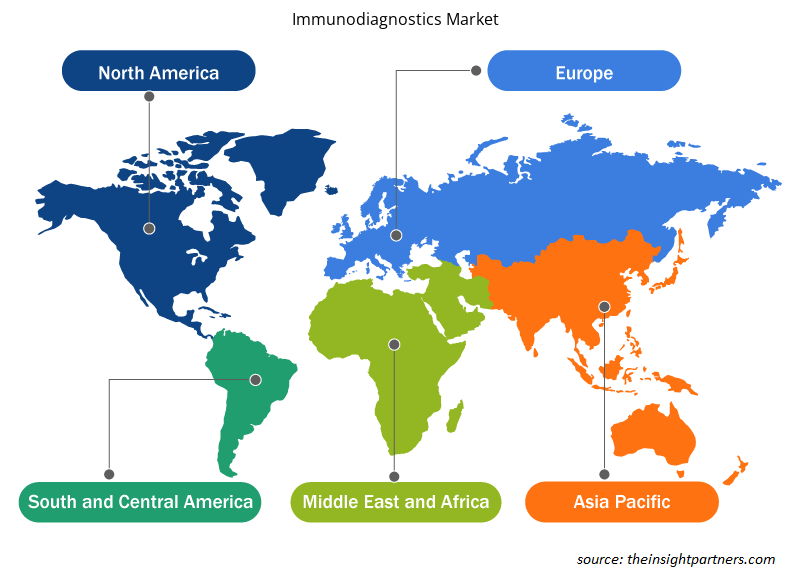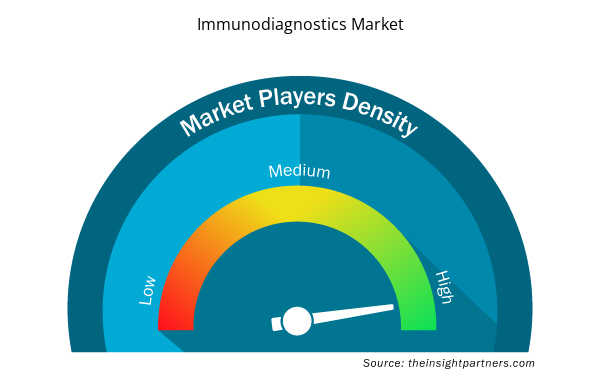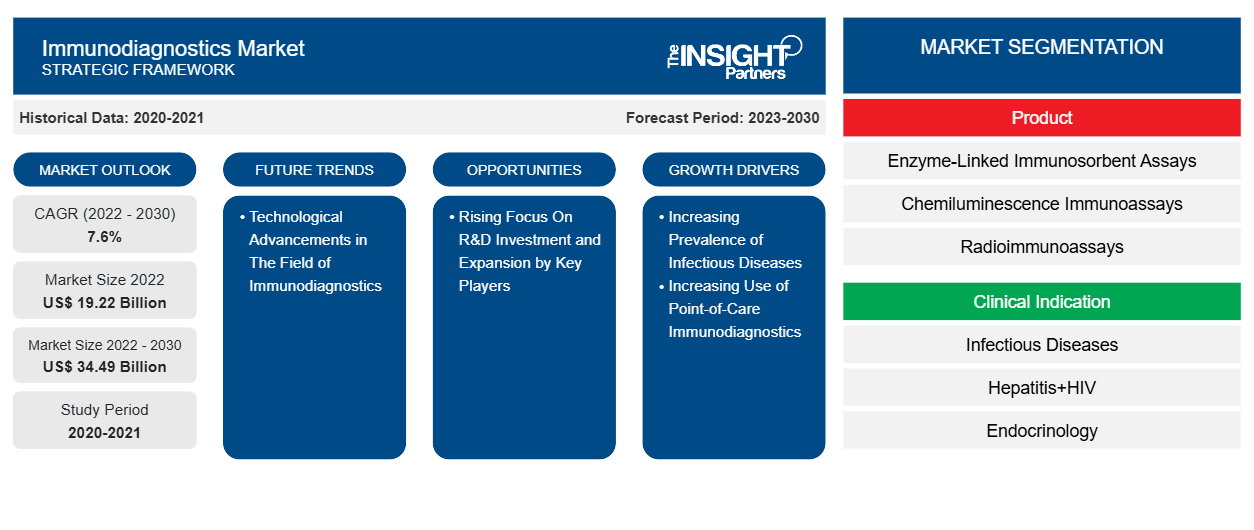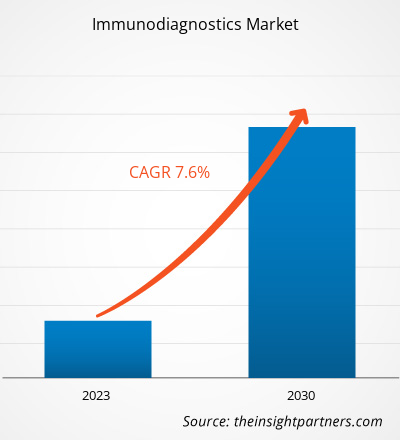[研究报告] 免疫诊断市场规模预计将从 2022 年的 192.1889 亿美元增长至 2030 年的 344.878 亿美元;预计 2022 年至 2030 年免疫诊断市场的复合年增长率为 7.6%。
分析师观点:
由于诊断领域的发展显著,免疫诊断市场 预计将蓬勃发展。在 COVID-19 大流行期间,免疫诊断市场增长得到推动。多家公司的产品获得了紧急授权,这有助于它们进入市场。此外,市场的增长主要归因于对更快诊断技术研发的投资增加。各公司做出了各种战略决策,以扩大其产品组合和地理覆盖范围。此外,预期寿命的提高导致老年人口显着增加,从而增加了对免疫诊断的需求。此外,人们意识的提高和健康标准的改变增加了对早期诊断的需求,从而推动了对各种诊断设备的需求。此外,对免疫诊断的发展及其益处的认识也增加了免疫诊断技术的使用。
市场概况:
免疫诊断是一种主要使用抗原抗体反应作为主要检测手段的诊断方法。针对所需抗原的特异性抗体可以与放射性标记、荧光标记或显色酶结合,并用作检测它的探针。此类测试的速度、准确性和简单性导致了快速诊断疾病、微生物甚至体内非法药物的技术的发展。推动传染病流行率上升和即时诊断使用率上升的关键因素推动了免疫诊断市场的增长。然而,报销不足阻碍了市场的增长。从地理上看,北美是最大的市场,其次是欧洲。在北美,美国占据免疫诊断市场的最大市场份额。亚太地区是全球免疫诊断市场增长最快的地区。在亚太地区,中国是免疫诊断的最大市场,预计在预测期内将保持主导地位。
定制此报告以满足您的需求
您可以免费定制任何报告,包括本报告的部分内容、国家级分析、Excel 数据包,以及为初创企业和大学提供优惠和折扣
- 获取此报告的关键市场趋势。这个免费样品将包括数据分析,从市场趋势到估计和预测。
市场驱动因素:
传染病发病率不断上升
由病毒、真菌、细菌、寄生虫或其毒性产物等传染性病原体引起的多种日益增多的传染病的诊断和管理,对免疫诊断测试的需求不断激增,例如补体结合试验、沉淀试验、凝集试验、线印迹试验、蛋白质印迹试验、酶联免疫吸附试验(EIA) 和免疫荧光测试。
人类免疫缺陷病毒 (HIV) 仍然是全球的主要公共卫生问题。根据联合国艾滋病规划署 (UNAIDS) 的数据,2021 年全球约有 3840 万人感染艾滋病毒。此外,肝炎是推动免疫诊断市场发展的另一个主要因素。根据世界卫生组织 (WHO) 的数据,全球有近 5800 万人患有慢性丙型肝炎感染,每年有 150 万例新发病例。此外,约有 320 万青少年和儿童感染丙型肝炎。经所有成员国批准的全球肝炎世卫组织战略旨在在 2016-2030 年期间将新发肝炎感染减少 90%,死亡率减少 65%。此类全球举措正在推动对免疫诊断产品的需求。
此外,结核病 (TB)、COVID-19 和其他医院获得性感染 (HAI) 需要进行免疫诊断测试。
- 结核病是全球第 13 大死亡原因,也是继新冠肺炎之后的第二大传染病杀手。2020 年,全球有 150 万人死于结核病,估计有 1000 万人受到影响,其中包括 560 万男性、330 万女性和 110 万儿童。
- 2021 年,美国 50 个州和哥伦比亚特区 (DC) 共向 CDC 的国家结核病监测系统 (NTSS) 报告了 7,860 例结核病病例。
- 据 Worldometer 报道,全球有数百万人因 COVID-19 疫情死亡。这给医疗系统带来了巨大压力,也增加了对免疫诊断测试的需求。
诊断在确定合适的医疗方法方面起着至关重要的作用。免疫诊断有助于诊断严重影响免疫系统的疾病。因此,传染病的流行率不断上升,导致对免疫诊断产品的需求激增。
细分分析:
全球免疫诊断市场细分为产品、临床适应症和最终用户。根据产品,市场细分为酶联免疫吸附测定 (ELISA)、化学发光免疫测定 (CLIA)、放射免疫测定(RIA) 和其他。按产品分类,酶联免疫吸附测定 (ELISA) 部分占据了最大的市场份额。传染病是由细菌、病毒、寄生虫和真菌等有害病原体进入人体引起的。它们通常通过受污染的食物或水和虫咬传播。传染病占据了免疫诊断市场的很大一部分。免疫诊断测试是为了补充传染病研究中分子检测的结果。几种免疫诊断测试用于诊断传染病、检测内分泌和肿瘤疾病以及测量血液药物浓度。基于酶的免疫测定使用抗体来检测抗原和量化抗体。蛋白质印迹试验是根据抗体与通过印迹固定在膜上的目标抗原(病毒成分)之间的反应来检测患者样本(例如血清或不同体液)中的抗体。
预计化学发光免疫分析 (CLIA) 部分将在预测期内实现最高复合年增长率。CLIA 部分进一步细分为维生素 D 分析、HIV 检测、HIV AG/AB 组合分析等。
根据临床指征,市场细分为传染病、肝炎+艾滋病毒、内分泌学、胃肠道、代谢等。传染病在 2022 年获得了最高的市场价值,预计在预测期内将实现最高的复合年增长率。传染病细分进一步细分为 COVID-19、结核病、莱姆病、感染管理、寨卡病毒、梅毒螺旋体、TORCH、麻疹和腮腺炎、VZV 和 EBV。同样,内分泌学细分进一步细分为高血压、生长、糖尿病、甲状腺和生殖内分泌学。
根据最终用户,免疫诊断市场分为医院、诊所、诊断实验室、学术和研究机构等。医院部门在 2022 年占据了最大的市场份额。诊所部门预计在预测期内将实现最高的复合年增长率。
区域分析:
北美占据全球免疫诊断市场的最大市场份额,2022 年价值 97.728 亿美元,复合年增长率为 7.5%。北美是免疫诊断的最大市场,美国、加拿大和墨西哥是该地区市场的主要贡献者。政府对采用先进诊断技术的支持日益增加、研发力度不断加大以及市场参与者的战略合作等举措,都促进了免疫诊断市场的显著增长。此外,诊断行业参与者的技术进步很可能成为未来几年北美免疫诊断市场的主要增长刺激因素。与此同时,亚太地区是全球免疫诊断市场增长最快的地区。美国是最大的市场,免疫诊断的增长是由需要诊断的癌症患病率不断上升以及免疫诊断领域的不断发展所推动的。
亚太免疫诊断市场分为中国、印度、日本、韩国、澳大利亚和亚太地区其他地区。亚太地区慢性病发病率不断上升,导致对诊断测试的需求大幅增加,这些测试可提供与疾病相关的检测、诊断和治疗等医疗保健基本细节。此外,国内企业对开发免疫诊断产品和技术的投资可能会在预测期内推动免疫诊断市场的增长。
免疫诊断市场区域洞察
Insight Partners 的分析师已详尽解释了预测期内影响免疫诊断市场的区域趋势和因素。本节还讨论了北美、欧洲、亚太地区、中东和非洲以及南美和中美洲的免疫诊断市场细分和地理位置。

- 获取免疫诊断市场的区域特定数据
免疫诊断市场报告范围
| 报告属性 | 细节 |
|---|---|
| 2022 年市场规模 | 192.2亿美元 |
| 2030 年的市场规模 | 344.9亿美元 |
| 全球复合年增长率(2022 - 2030 年) | 7.6% |
| 史料 | 2020-2021 |
| 预测期 | 2023-2030 |
| 涵盖的领域 | 按产品
|
| 覆盖地区和国家 | 北美
|
| 市场领导者和主要公司简介 |
|
免疫诊断市场参与者密度:了解其对业务动态的影响
免疫诊断市场正在快速增长,这得益于终端用户需求的不断增长,而这些需求又源于消费者偏好的不断变化、技术进步以及对产品优势的认识不断提高等因素。随着需求的增加,企业正在扩大其产品范围,进行创新以满足消费者的需求,并利用新兴趋势,从而进一步推动市场增长。
市场参与者密度是指在特定市场或行业内运营的企业或公司的分布情况。它表明相对于给定市场空间的规模或总市场价值,有多少竞争对手(市场参与者)存在于该市场空间中。
在免疫诊断市场运营的主要公司有:
- 雅培实验室
- F. 霍夫曼-罗氏有限公司
- 迪亚索林公司
- 丹纳赫公司
- 赛默飞世尔科技公司
免责声明:上面列出的公司没有按照任何特定顺序排列。

- 获取免疫诊断市场顶级关键参与者概述
关键球员分析:
免疫诊断市场主要由雅培实验室、罗氏有限公司、DiaSorin SpA、丹纳赫公司、赛默飞世尔科技公司、珀金埃尔默公司、深圳迈瑞生物医疗电子股份有限公司、bioMerieux SA、Svar Life Science AB 和西门子医疗股份公司等参与者组成。
雅培实验室和 F. Hoffmann-La Roche Ltd 是免疫诊断市场的前两大参与者。这些公司一直在实施各种战略,这些战略有助于公司的发展,进而带来了市场的各种变化。这些公司采用了有机战略,例如发布、扩张和产品批准。另一方面,产品发布、伙伴关系和合作等无机战略在免疫诊断市场中很常见。
最新动态:
免疫诊断市场中的公司普遍采用无机和有机策略。以下列出了一些近期的关键市场发展:
- 2023 年 4 月,赛默飞世尔科技宣布与全球诊断领导者 ALPCO-GeneProof 建立合作伙伴关系。此次合作有助于将 TaqPath Menu | GeneProof PCR 试剂盒推向市场。
- 2022年7月,雅培诊断宣布参加2022年美国临床化学协会(AACC),在展会上展示了其诊断系统和分析仪。
- 2023年5月,赛默飞世尔科技宣布,美国FDA已批准其免疫测定法B·R·A·H·M·S PlGF plus KRYPTOR和B·R·A·H·M·S sFlt-1 KRYPTOR新型生物标志物。这些免疫测定法可评估严重妊娠并发症先兆子痫的风险和临床管理。
- 历史分析(2 年)、基准年、预测(7 年)及复合年增长率
- PEST 和 SWOT 分析
- 市场规模价值/数量 - 全球、区域、国家
- 行业和竞争格局
- Excel 数据集


- Animal Genetics Market
- Educational Furniture Market
- Semiconductor Metrology and Inspection Market
- Fertilizer Additives Market
- Photo Editing Software Market
- Asset Integrity Management Market
- Thermal Energy Storage Market
- Quantitative Structure-Activity Relationship (QSAR) Market
- Human Microbiome Market
- Drain Cleaning Equipment Market

Report Coverage
Revenue forecast, Company Analysis, Industry landscape, Growth factors, and Trends

Segment Covered
This text is related
to segments covered.

Regional Scope
North America, Europe, Asia Pacific, Middle East & Africa, South & Central America

Country Scope
This text is related
to country scope.
常见问题
The enzyme-linked immunosorbent assays (ELISA) segment held the largest share of the market in 2022. Whereas the chemiluminescence immunoassays (CLIA) segment is estimated to register the highest CAGR in the market during the forecast period.
The immunodiagnostics market is expected to be valued at US$ 34,487.80 million in 2030.
The immunodiagnostics market is estimated to be valued at US$ 19,218.89 million in 2022.
The CAGR value of the immunodiagnostics market during the forecasted period of 2022-2028 is 7.6%.
The Asia Pacific is expected to be the fastest-growing region in the immunodiagnostics market over the forecast period due to the infectious diseases and the growing use of point-of-care immunodiagnostics, and developments by market players offering immunodiagnostics.
The immunodiagnostics market majorly consists of the players, such as Abbott Laboratories, F. Hoffmann-La Roche Ltd, DiaSorin SpA, Danaher Corp, Thermo Fisher Scientific Inc, PerkinElmer Inc, Shenzhen Mindray Bio-Medical Electronics Co Ltd, bioMerieux SA, Svar Life Science AB, and Siemens Healthineers AG.
The factors that are driving the growth of the immunodiagnostics market are the rising prevalence of infectious diseases and the growing use of point-of-care immunodiagnostics.
Immunodiagnostics is referred as a diagnostic methodology that primarily uses antigen-antibody reaction as its primary means of detection. Antibodies specific for a desired antigen can be conjugated with a radiolabel, fluorescent label, or color-forming enzyme and are used as a probe to detect it. The speed, accuracy and simplicity of such tests has led to the development of rapid techniques for the diagnosis of disease, microbes and even illegal drugs in vivo.
Trends and growth analysis reports related to Life Sciences : READ MORE..
The List of Companies - Immunodiagnostics Market
- Abbott Laboratories
- F. Hoffmann-La Roche Ltd
- DiaSorin SpA
- Danaher Corporation
- Thermo Fisher Scientific Inc
- PerkinElmer Inc
- Shenzhen Mindray Bio-Medical Electronics Co Ltd
- bioMerieux SA
- Svar Life Science AB
- Siemens Healthineers AG.
The Insight Partners performs research in 4 major stages: Data Collection & Secondary Research, Primary Research, Data Analysis and Data Triangulation & Final Review.
- Data Collection and Secondary Research:
As a market research and consulting firm operating from a decade, we have published and advised several client across the globe. First step for any study will start with an assessment of currently available data and insights from existing reports. Further, historical and current market information is collected from Investor Presentations, Annual Reports, SEC Filings, etc., and other information related to company’s performance and market positioning are gathered from Paid Databases (Factiva, Hoovers, and Reuters) and various other publications available in public domain.
Several associations trade associates, technical forums, institutes, societies and organization are accessed to gain technical as well as market related insights through their publications such as research papers, blogs and press releases related to the studies are referred to get cues about the market. Further, white papers, journals, magazines, and other news articles published in last 3 years are scrutinized and analyzed to understand the current market trends.
- Primary Research:
The primarily interview analysis comprise of data obtained from industry participants interview and answers to survey questions gathered by in-house primary team.
For primary research, interviews are conducted with industry experts/CEOs/Marketing Managers/VPs/Subject Matter Experts from both demand and supply side to get a 360-degree view of the market. The primary team conducts several interviews based on the complexity of the markets to understand the various market trends and dynamics which makes research more credible and precise.
A typical research interview fulfils the following functions:
- Provides first-hand information on the market size, market trends, growth trends, competitive landscape, and outlook
- Validates and strengthens in-house secondary research findings
- Develops the analysis team’s expertise and market understanding
Primary research involves email interactions and telephone interviews for each market, category, segment, and sub-segment across geographies. The participants who typically take part in such a process include, but are not limited to:
- Industry participants: VPs, business development managers, market intelligence managers and national sales managers
- Outside experts: Valuation experts, research analysts and key opinion leaders specializing in the electronics and semiconductor industry.
Below is the breakup of our primary respondents by company, designation, and region:

Once we receive the confirmation from primary research sources or primary respondents, we finalize the base year market estimation and forecast the data as per the macroeconomic and microeconomic factors assessed during data collection.
- Data Analysis:
Once data is validated through both secondary as well as primary respondents, we finalize the market estimations by hypothesis formulation and factor analysis at regional and country level.
- Macro-Economic Factor Analysis:
We analyse macroeconomic indicators such the gross domestic product (GDP), increase in the demand for goods and services across industries, technological advancement, regional economic growth, governmental policies, the influence of COVID-19, PEST analysis, and other aspects. This analysis aids in setting benchmarks for various nations/regions and approximating market splits. Additionally, the general trend of the aforementioned components aid in determining the market's development possibilities.
- Country Level Data:
Various factors that are especially aligned to the country are taken into account to determine the market size for a certain area and country, including the presence of vendors, such as headquarters and offices, the country's GDP, demand patterns, and industry growth. To comprehend the market dynamics for the nation, a number of growth variables, inhibitors, application areas, and current market trends are researched. The aforementioned elements aid in determining the country's overall market's growth potential.
- Company Profile:
The “Table of Contents” is formulated by listing and analyzing more than 25 - 30 companies operating in the market ecosystem across geographies. However, we profile only 10 companies as a standard practice in our syndicate reports. These 10 companies comprise leading, emerging, and regional players. Nonetheless, our analysis is not restricted to the 10 listed companies, we also analyze other companies present in the market to develop a holistic view and understand the prevailing trends. The “Company Profiles” section in the report covers key facts, business description, products & services, financial information, SWOT analysis, and key developments. The financial information presented is extracted from the annual reports and official documents of the publicly listed companies. Upon collecting the information for the sections of respective companies, we verify them via various primary sources and then compile the data in respective company profiles. The company level information helps us in deriving the base number as well as in forecasting the market size.
- Developing Base Number:
Aggregation of sales statistics (2020-2022) and macro-economic factor, and other secondary and primary research insights are utilized to arrive at base number and related market shares for 2022. The data gaps are identified in this step and relevant market data is analyzed, collected from paid primary interviews or databases. On finalizing the base year market size, forecasts are developed on the basis of macro-economic, industry and market growth factors and company level analysis.
- Data Triangulation and Final Review:
The market findings and base year market size calculations are validated from supply as well as demand side. Demand side validations are based on macro-economic factor analysis and benchmarks for respective regions and countries. In case of supply side validations, revenues of major companies are estimated (in case not available) based on industry benchmark, approximate number of employees, product portfolio, and primary interviews revenues are gathered. Further revenue from target product/service segment is assessed to avoid overshooting of market statistics. In case of heavy deviations between supply and demand side values, all thes steps are repeated to achieve synchronization.
We follow an iterative model, wherein we share our research findings with Subject Matter Experts (SME’s) and Key Opinion Leaders (KOLs) until consensus view of the market is not formulated – this model negates any drastic deviation in the opinions of experts. Only validated and universally acceptable research findings are quoted in our reports.
We have important check points that we use to validate our research findings – which we call – data triangulation, where we validate the information, we generate from secondary sources with primary interviews and then we re-validate with our internal data bases and Subject matter experts. This comprehensive model enables us to deliver high quality, reliable data in shortest possible time.


 获取此报告的免费样本
获取此报告的免费样本